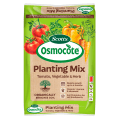

How to grow fennel
Fennel or Florence Fennel (Foeniculum vulgare dulce) produces crisp white bulbs, topped with fern like fronds - all parts of the plant (including the seeds) are edible and have a distinctive aniseed taste.
Fennel will grow in all climates and is normally planted in the spring in cooler regions or autumn in warmer areas. If you’ve had a problem with fennel bolting to seed - try growing it in your coolest months.
It’s easiest to grow fennel from seeds sown directly. The bulbs will be ready to harvest in 14-20 weeks, depending on your climate. While you wait for the bulbs to mature, the fine fronds can be harvested as needed to garnish or flavour various dishes.
Other types of fennel:
- Bronze Fennel (Foeniculum vulgare ‘Purpureum’) - an ornamental fennel grown for its bronze/purple foliage that is also edible and flavourful
- Green or common fennel (Foeniculum vulgare) - is considered an invasive weed in many areas of Australia, please check with your local council before planting it
Top 4 steps to growing fennel
- Choose a full sun position & grow in your cooler months
- Improve the soil before planting by adding compost or Scotts Osmocote® Compost Premium Soil Improver
- Direct sow fennel seeds into prepared soil, allowing 20cm between plants.
- Harvest fennel seeds to dry and use in your kitchen or save them to replant the following year.
Shopping List
- Fennel seeds
- Scotts Osmocote® Compost Premium Soil Improver
- Scotts Osmocote® Controlled Release Fertiliser: Tomato, Vegetable & Herb
- If growing in pots, Scotts Osmocote® Plus Organics Tomato, Vegetable & Herb Potting Mix
- Garden trowel
- Defender Slug & Snail Pellets
Prepare
Fennel is best grown from seeds, direct sown in a full sun spot. Enriched the soil before sowing with Scotts Osmocote® Compost Premium Soil Improver and a small amount of Scotts Osmocote® Controlled Release Fertiliser: Tomato, Vegetable & Herb - dig these through the top 10-20cm of soil before planting.
Planting fennel in the garden
Sow fennel seeds into prepared soil, allowing 20cm between each seed if you can and lightly cover with soil. If you sow too densely, don’t panic, the seedlings can be thinned to a 20-25cm spacing as they grow.
Keep the soil moist, but not soggy while the seeds germinate - which will take 7-14 days. Re-sow fennel seeds every 6-12 weeks for a continuous supply.
Planting fennel in pots
Fennel isn’t typically recommended for growing in pots because you won’t fit many plants in a pot! However, if you have to grow in pots - choose a large and long, trough-style planter and you might be able to squeeze in 6-8 plants depending on its size.
Fill the pot with Scotts Osmocote® Plus Organics Tomato, Vegetable & Herb Potting Mix and thinly sprinkle seeds on the surface. Cover lightly with more potting mix and keep them moist while they germinate.
Fennel seedlings can be thinned to 20-25m apart as they grow.
Harvesting fennel
Fennel bulbs are ready to harvest when they are about the size of a tennis ball. Either pull the plant completely from the ground when ready to harvest or you can cut it off at ground level.
Fennel fronds or leaves are also edible, just snip them off at any stage as your fennel grows - leaving enough fronds/leaves to support the plant's growth.
Fennel flowers and seeds are also edible. Use fennel flowers to decorate cakes and salads. Or dry fennel seed heads and save the seeds to use in curries, stews and other sweet or savoury dishes.
Pests & Diseases
Slugs and Snails will cause significant damage to fennel bulbs. Protect your fennel crop by setting beer traps (saucers filled with beer) or use Defender Slug & Snail Pellets.
Excessive water can cause root rot and sudden plant death, avoid over watering and make sure your soil is free draining.



